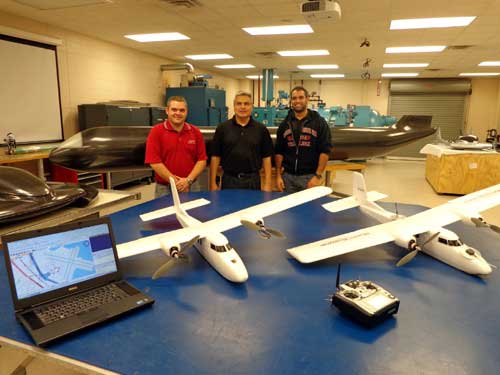FAA Approval Makes Way for Expanded UAV Research
Author: News Bureau
Posted: Thursday, December 13, 2012 12:45 PM
Category:
School of Aviation
Macon, GA

The Federal Aviation Administration recently granted the Aviation Campus, located in Eastman, a second Certificate of Authorization to fly and test the TwinStar II UAV at a site near the Heart of Georgia Regional Airport. The Dodge County Development Authority is acquiring a site located about six miles from the airport and the Aviation Campus that is suitable to test and develop smaller-class UAVs, said Chad Dennis, a program coordinator with the Georgia Center of Innovation for Aerospace, which has offices on the Aviation Campus and in Atlanta.
Dennis said that the significance of the FAA's decision rests in how few Certificate of Authorizations the agency grants to fly and test UAVs in what is known as the National Airspace System. The one that the Aviation Campus recently received is its second, and there are only 400 active CoAs in the entire nation, Dennis said.
The TwinStar II will be used for agricultural sensor research, as well as training of Unmanned Aerial Systems flight crews, consisting of Aviation Campus interns, faculty and staff.
According to the U.S. Defense Department website, UAVs are defined as powered aerial vehicles sustained in flight by aerodynamic lift over most of their flight path and guided without an onboard crew. They may be expendable or recoverable and can fly autonomously or piloted remotely. Their military applications are best known, but research into civil/commercial uses is growing rapidly.
With its first CoA, the Aviation Campus conducted Prototype-Technology Evaluator and Research Aircraft (PTERA) research flights during the summer of 2012.
"This was the first time a UAV of that type was flown in the National Airspace System," Dennis said. "The aerospace Innovation Center partnered with Area-I, a Georgia company that developed the concept of the PTERA, and with NASA and the Heart of Georgia Regional Airport Authority to conduct the public research flights."
The PTERA used in those research flights was built by Aviation Campus students, faculty and staff under the direction of Rick Krontz, director of the campus's Institute of Applied Aviation Research. Krontz is working on multiple UAV development projects.
Photo: Left to right, Chad Dennis, Unmanned Aerial Systems (UAS) Program Coordinator for the Georgia Center of Innovation for Aerospace and Middle Georgia College instructor in the Aircraft Structural Technology (AST) Department; Rick Krontz, Director of the Institute for Applied Aerospace Research; and Michael Mendez, student intern.
